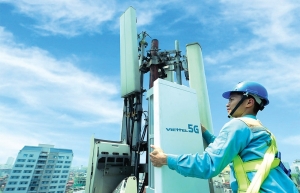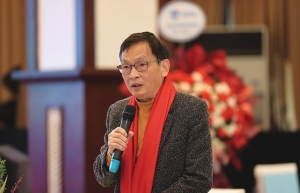5G experiences will guide way for Vietnam
According to the 2023 Ericsson Mobility Report, 5G subscriptions will reach around 550 million in Southeast Asia and Oceania by the end of the decade. Beyond Southeast Asia, the global average data consumption per smartphone keeps growing. Total mobile data traffic is estimated to grow threefold between now and 2030, attributed to factors such as improved device capabilities, an increase in data intensive content, and continued improvements in the performance of deployed networks.
 |
| Hoang Viet Tien, deputy secretary general Vietnam Digital Communication Association |
The race to commercialise 5G services continues in the context of 5G networks being rapidly deployed globally. Experts said that 5G has developed faster than 4G in the two years since this technology was launched. The rapid deployment comes from many reasons, including the availability of low-cost 5G-enabled devices from many vendors and the early large-scale deployment of 5G in many pioneer markets.
Because 5G is the new global mobile communications standard, mobile service providers in emerging markets in Asia are also planning to switch off previous mobile generations such as 2G and 3G to reuse this frequency spectrum for 4G and 5G networks. Besides that, as countries in Asia are starting or increasing their digitalisation plans, developing 5G is also one of the strategies for countries to achieve a dynamic digital economy.
South Korea was the first country in the world to deploy commercial 5G, in 2019. It has taken the lead in rolling out 5G mobile networks, opening up new technological and economic opportunities. However, the journey has not been perfect yet, posing notable challenges that need to be overcome.
When 5G began to be deployed, many consumers in South Korea were overwhelmed by the small improvements in speed and connection. The quality and speed of the network has since then improved thanks to technologies such as standalone 5G that runs on its own network infrastructure instead of relying partly on the network infrastructure of 4G.
A major cause of low 5G speeds in South Korea is the use of mid-bands instead of high-bands that support millimetre waves, which deliver higher speeds. However, transmitting radio waves on high-frequency bands faces many difficulties when having to overcome obstacles such as trees and buildings.
In addition, another big challenge is the lack of outstanding 5G applications. Although there have been promises of technology opening up a new era of smart cities and self-driving cars, the facts show that these applications are still being pursued without being widely deployed.
In Japan, commercial 5G networks were launched by major Japanese mobile carriers NTT Docomo, KDDI, and SoftBank in 2020. The deployment of such networks by Japanese mobile service providers is initially focused on urban areas and crowded places such as airports, train stations, aiming for 95 per cent coverage of the population by March 2024 and 99 per cent of the population by 2031.
After nearly three years of deployment in Japan, the 5G network coverage rate has reached nearly 40 per cent of the population, with about 22,000 5G base stations deployed. By March 2022, the number of 5G mobile subscribers in Japan had reached 45 million.
Meanwhile, Singapore was the first country in the world to be completely covered by a 5G network based on standalone architecture, after the country’s Singtel network reached a coverage rate of up to 95 per cent, three years earlier than the initial target of 2025.
In addition to Singtel, other mobile service providers such as M1 and Starhub are also accelerating 5G coverage, of which Singtel’s rival M1 has currently reached 75 per cent of coverage, and striving to reach 95 per cent by the end of the year. Along with that, Singapore’s mobile operators are also focusing on developing 5G-based innovative services for businesses with active support from the government and regulatory agencies.
Over in Thailand, mobile service providers have been quick to roll out 5G coverage nationwide, and it now covers more than 80 per cent of the country’s population.
In Indonesia, 5G technology has covered major cities since 2021. Leading mobile service providers there have offered commercial 5G services through licensed bands. However, network deployment has been slowed due to a lack of spectrums in the mid-band.
5G commercialisation is a challenging path which needs the involvement of all parties. Vietnam is still in the initial stage of 5G commercialisation. In the initial phase, 5G will enable service providers in Vietnam to provide enhanced mobile broadband experience to consumers and enhance the capacity of the networks to manage the growing data traffic. Over time, it is expected that innovative use cases will emerge for many businesses.
On this journey, deployment of commercial 5G in the region could be useful lessons for Vietnam and its mobile network operators to learn from to ensure its future success. To enable 5G to contribute more to the country’s GDP growth, challenges related to infrastructure and investment should be solved, while having supporting policies for local network operators.
 | Huawei to develop 5G innovation centre in Vietnam Huawei is proposing the development of a 5G innovation centre in Vietnam as part of the Chinese tech giant's intention to support Vietnam's roll out of commercialised 5G services. |
 | 5G network inches ever closer Investment returns may be some way off for telecoms groups, despite taking on ownership of 5G frequency bands via auction. |
 | New era opens for 5G commercialisation The March auction of frequency bands for 5G marks an important milestone in the country’s 5G commercialisation. The auction of the B1 and C2 frequency band blocks was successful, while the C3 band was not, as not enough qualified businesses were interested. |
 | Accelerating Vietnam’s journey towards 5G 5G remains on track to become the fastest-adopted mobile generation: 5G mobile subscriptions are forecast to have topped 1.6 billion at the end of 2023, and 5.3 billion by 2030. However, we are still early in the 5G cycle and only 28 per cent of 4G sites globally have been upgraded to 5G mid-band. Likewise, only 1.6b 5G subscribers, out of a total of 8.5b mobile subscriptions, enjoy the benefits of 5G. |
What the stars mean:
★ Poor ★ ★ Promising ★★★ Good ★★★★ Very good ★★★★★ Exceptional
Themes: Digital Transformation
- Viettel starts construction of semiconductor chip production plant
- Vietnam, UN strengthen cooperation in digital technology, AI
- Vietnamese firms win top honours at ASEAN Digital Awards
- ASEAN Digital Ministers' Meeting opens in Hanoi
- TECHFEST Vietnam 2025 links startups with policy and capital
Related Contents
Latest News
More News
- State sector sees broad-based profit surge as major groups deliver strong results (January 13, 2026 | 17:34)
- HSBC forecasts Vietnam's GDP growth to hit 6.7 per cent in 2026 (January 13, 2026 | 17:33)
- Japfa maintains position in top 10 animal feed firms (January 13, 2026 | 10:18)
- Roadmap shaping up to phase out gas bikes (January 13, 2026 | 10:07)
- FDI momentum accelerates transformation of Vietnam’s plastics sector (January 11, 2026 | 07:00)
- UOB lifts Vietnam growth outlook to 7.5 per cent for 2026 (January 10, 2026 | 09:00)
- Exports cement role as central pillar (January 09, 2026 | 12:37)
- Siemens and NVIDIA expand partnership to build industrial AI operating system (January 09, 2026 | 10:04)
- High targets, hard choices: companies weigh risks in 2026 (January 08, 2026 | 16:58)
- Murphy Oil Corporation achieves appraisal success at Hai Su Vang oil field (January 08, 2026 | 11:35)

 Tag:
Tag:


















 Mobile Version
Mobile Version